原文:
https://mp.weixin.qq.com/s/CTIQN9srXkn5BTWCK85Orw
前言
协程(Coroutines),是 Kotlin 「最神奇」 的特性,没有之一。
本文会以图解 + 动画的形式解释 Kotlin 协程的原理。看完本文后,你会发现,原来协程也没有那么难。

本文要求读者有一定的 Kotlin 基础,欢迎阅读《Kotlin Jetpack 实战》其他文章。
1. 一边看文章,一边跑 Demo
本文的 Demo:
https://github.com/chaxiu/KotlinJetpackInAction[1]
2. 线程 & 协程
很多主流编程语言都支持协程,比如:C#,Python,Lua,就连C++20都开始也支持协程了。理解了 Kotlin 的协程以后,你会惊喜的发现其他语言里的协程也很容易理解了。
有的人会将协程比喻成:线程的封装框架,从宏观角度是可以这么理解,但 Kotlin 官方最喜欢说:协程有点像轻量级的线程。
协程能轻量到什么程度?就算你在一个线程中创建1000个协程,也不会有什么影响。
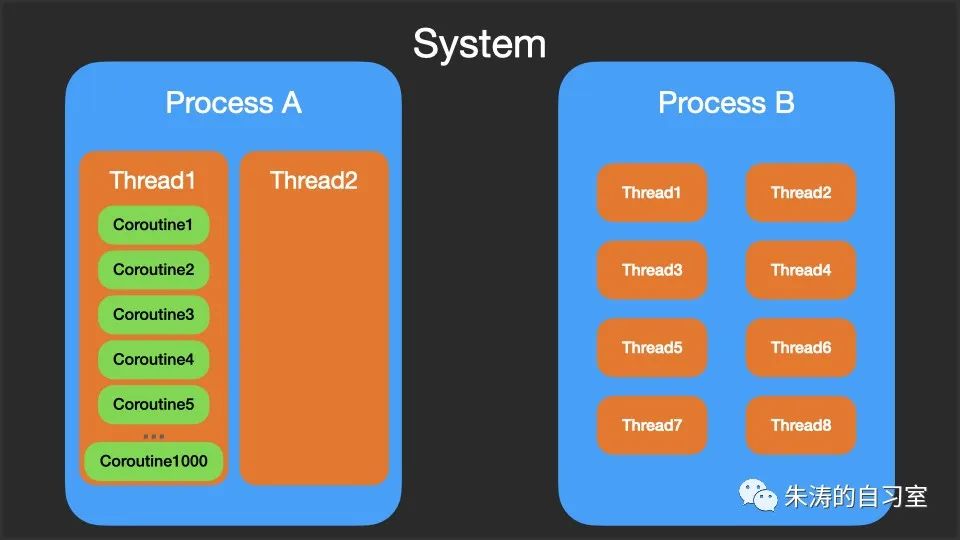
「从包含关系上看,协程跟线程的关系,有点像“线程与进程的关系”,毕竟,协程不可能脱离线程运行。」
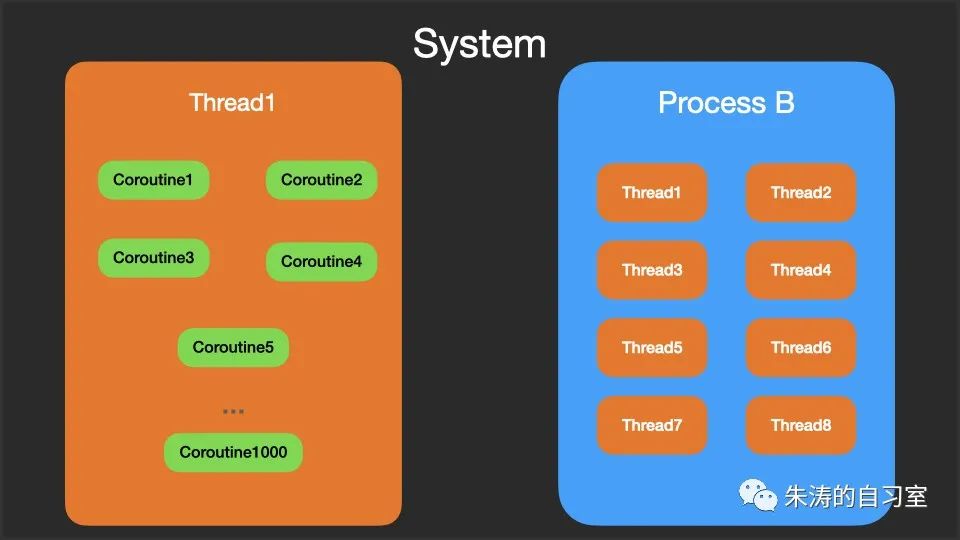
协程虽然不能脱离线程而运行,但可以在不同的线程之间切换。看到这,大家应该能理解本文最开始放的那张动图的含义了吧?

说了这么多协程的好,但就凭它的”高效“,”轻量“我们就要用吗?汇编语言也很高效啊。C 语言也能写出轻量的程序啊。
高效和轻量,都不是 Kotlin 协程的核心竞争力。
「Kotlin 协程的核心竞争力在于:它能简化异步并发任务。」
作为 Java 开发者,我们很清楚线程并发是多么的危险,写出来的异步代码是多么的难以维护。
3. 异步代码 & 回调地狱
以一段简单的 Java 代码为例,我们发起了一个异步请求,从服务端查询用户的信息,通过 CallBack 返回 response:
getUserInfo(new CallBack() {
@Override
public void onSuccess(String response) {
if (response != null) {
System.out.println(response);
}
}
});
到目前为止,我们的代码看起来并没有什么问题,但如果我们的需求变成了这样呢?
查询用户信息 --> 查找该用户的好友列表 -->拿到好友列表后,查找该好友的动态
getUserInfo(new CallBack() {
@Override
public void onSuccess(String user) {
if (user != null) {
System.out.println(user);
getFriendList(user, new CallBack() {
@Override
public void onSuccess(String friendList) {
if (friendList != null) {
System.out.println(friendList);
getFeedList(friendList, new CallBack() {
@Override
public void onSuccess(String feed) {
if (feed != null) {
System.out.println(feed);
}
}
});
}
}
});
}
}
});
有点恶心了,是不是?这还是仅包含 onSuccess 的情况,实际情况会更复杂,因为我们还要处理异常,处理重试,处理线程调度,甚至还可能涉及多线程同步。
4. 地狱到天堂:协程
今天的主角是协程,上面的代码用协程应该写?很简单,核心就是三行代码:
val user = getUserInfo()
val friendList = getFriendList(user)
val feedList = getFeedList(friendList)
是不是简洁到了极致?这就是 Kotlin 协程的魅力:以同步的方式完成异步任务。
4-1 使用协程的要点
以上代码的关键,在于那三个请求函数的定义,它们都被 suspend 修饰,这代表它们都是:挂起函数。
// delay(1000L)用于模拟网络请求
//挂起函数
// ↓
suspend fun getUserInfo(): String {
withContext(Dispatchers.IO) {
delay(1000L)
}
return "BoyCoder"
}
//挂起函数
// ↓
suspend fun getFriendList(user: String): String {
withContext(Dispatchers.IO) {
delay(1000L)
}
return "Tom, Jack"
}
//挂起函数
// ↓
suspend fun getFeedList(list: String): String {
withContext(Dispatchers.IO) {
delay(1000L)
}
return "{FeedList..}"
}
那么,挂起函数到底是什么?
4-2 挂起函数
挂起函数(Suspending Function),从字面上理解,就是可以被挂起的函数。suspend 有:挂起,暂停的意思。在这个语境下,也有点暂停的意思。暂停更容易被理解,但挂起更准确。
挂起函数,能被 「挂起」,当然也能 「恢复」,他们一般是成对出现的。
我们来看看挂起函数的执行流程,注意动画当中出现的闪烁,这代表正在请求网络。
「一定要多看几遍,确保没有遗漏其中的细节。」
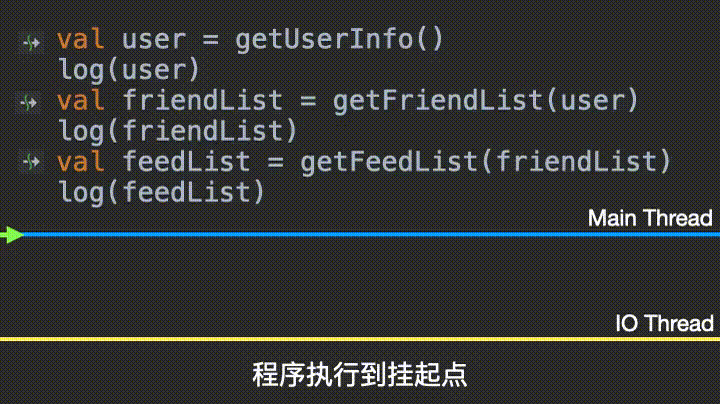
从上面的动画,我们能知道:
- 表面上看起来是同步的代码,实际上也涉及到了线程切换。
- 一行代码,切换了两个线程。
=左边:主线程=右边:IO线程- 每一次从
主线程到IO线程,都是一次协程挂起(suspend) - 每一次从
IO线程到主线程,都是一次协程恢复(resume)。 - 挂起和恢复,这是挂起函数特有的能力,普通函数是不具备的。
- 挂起,只是将程序执行流程转移到了其他线程,主线程并未被阻塞。
- 如果以上代码运行在 Android 系统,我们的 App 是仍然可以响应用户的操作的,主线程并不繁忙,这也很容易理解。
挂起函数的执行流程我们已经很清楚了,那么,Kotlin 协程到底是如何做到一行代码切换两个线程的?
这一切的魔法都藏在了挂起函数的suspend关键字里。
5. suspend 的本质
suspend 的本质,就是 CallBack。
suspend fun getUserInfo(): String {
withContext(Dispatchers.IO) {
delay(1000L)
}
return "BoyCoder"
}
有的小伙伴要问了,哪来的 CallBack?明明没有啊。确实,我们写出来的代码没有 CallBack,但 Kotlin 的编译器检测到 suspend 关键字修饰的函数以后,会自动将挂起函数转换成带有 CallBack 的函数。
如果我们将上面的挂起函数反编译成 Java,结果会是这样:
// Continuation 等价于 CallBack
// ↓
public static final Object getUserInfo(Continuation $completion) {
...
return "BoyCoder";
}
从反编译的结果来看,挂起函数确实变成了一个带有 CallBack 的函数,只是这个 CallBack 的真实名字叫 Continuation。毕竟,如果直接叫 CallBack 那就太 low,对吧?
我们看看 Continuation 在 Kotlin 中的定义:
public interface Continuation<in T> {
public val context: CoroutineContext
// 相当于 onSuccess 结果
// ↓ ↓
public fun resumeWith(result: Result<T>)
}
对比着看看 CallBack 的定义:
interface CallBack {
void onSuccess(String response);
}
从上面的定义我们能看到:Continuation 其实就是一个带有泛型参数的 CallBack,除此之外,还多了一个 CoroutineContext,它就是协程的上下文。对于熟悉 Android 开发的小伙伴来说,不就是 context 嘛!也没什么难以理解的,对吧?
以上这个从挂起函数转换成CallBack 函数的过程,被称为:CPS 转换(Continuation-Passing-Style Transformation)。
看,Kotlin 官方用 Continuation 而不用 CallBack 的原因出来了:Continuation 道出了它的实现原理。当然,为了理解挂起函数,我们用 CallBack 会更加的简明易懂。
下面用动画演示挂起函数在 CPS 转换过程中,函数签名的变化:
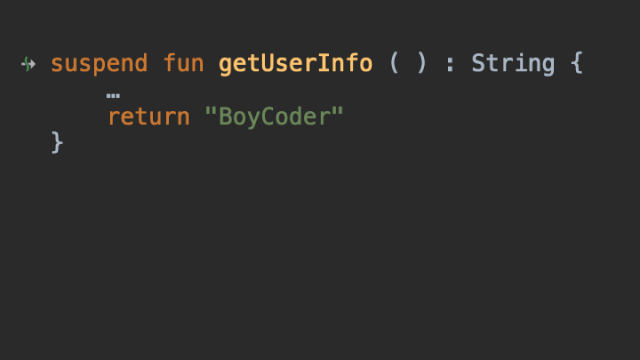
这个转换看着简单,其中也藏着一些细节。
函数类型的变化
上面 CPS 转换过程中,函数的类型发生了变化:suspend ()->String 变成了 (Continuation)-> Any?。
这意味着,如果你在 Java 访问一个 Kotlin 挂起函数getUserInfo(),在 Java 看到 getUserInfo() 的类型会是:(Continuation)-> Object。(接收 Continuation 为参数,返回值是 Object)
在这个 CPS 转换中,suspend () 变成 (Continuation) 我们前面已经解释了,不难。那么函数的返回值为什么会从:String变成Any?
挂起函数的返回值
挂起函数经过 CPS 转换后,它的返回值有一个重要作用:标志该挂起函数有没有被挂起。
这听起来有点绕:挂起函数,就是可以被挂起的函数,它还能不被挂起吗?是的,挂起函数也能不被挂起。
让我们来理清几个概念:
只要有 suspend 修饰的函数,它就是挂起函数,比如我们前面的例子:
suspend fun getUserInfo(): String {
withContext(Dispatchers.IO) {
delay(1000L)
}
return "BoyCoder"
}
当 getUserInfo() 执行到 withContext的时候,就会返回 CoroutineSingletons.COROUTINE_SUSPENDED 表示函数被挂起了。
现在问题来了,请问下面这个函数是挂起函数吗:
// suspend 修饰
// ↓
suspend fun noSuspendFriendList(user: String): String{
// 函数体跟普通函数一样
return "Tom, Jack"
}
答案:它是挂起函数。但它跟一般的挂起函数有个区别:它在执行的时候,并不会被挂起,因为它就是普通函数。当你写出这样的代码后,IDE 也会提示你,suspend 是多余的:

当 noSuspendFriendList() 被调用的时候,不会挂起,它会直接返回 String 类型:"no suspend"。这样的挂起函数,你可以把它看作**「伪挂起函数」**
返回类型是 Any?的原因
由于 suspend 修饰的函数,既可能返回 CoroutineSingletons.COROUTINE_SUSPENDED,也可能返回实际结果"no suspend",甚至可能返回 null,为了适配所有的可能性,CPS 转换后的函数返回值类型就只能是 Any?了。
小结
- suspend 修饰的函数就是
挂起函数 - 挂起函数,在执行的时候并不一定都会挂起
- 挂起函数只能在其他挂起函数中被调用(or 协程作用域)
- 挂起函数里包含其他挂起函数的时候,它才会真正被挂起
以上就是 CPS 转换过程中,函数签名的细节。
然而,这并不是 CPS 转换的全部,因为我们还不知道 Continuation 到底是什么。
6. CPS 转换
Continuation 这个单词,如果你查词典[2]和维基百科[3],可能会一头雾水,太抽象了。
通过我们文章的例子来理解 Continuation,会更容易一些。
首先,我们只需要把握住 Continuation 的词源 Continue 即可。Continue 是继续的意思,Continuation 则是继续下去要做的事情,接下来要做的事情。
放到程序中,Continuation 则代表了,程序继续运行下去需要执行的代码,接下来要执行的代码 或者 剩下的代码。
以上面的代码为例,当程序运行 getUserInfo() 的时候,它的 Continuation则是下图红框的代码:
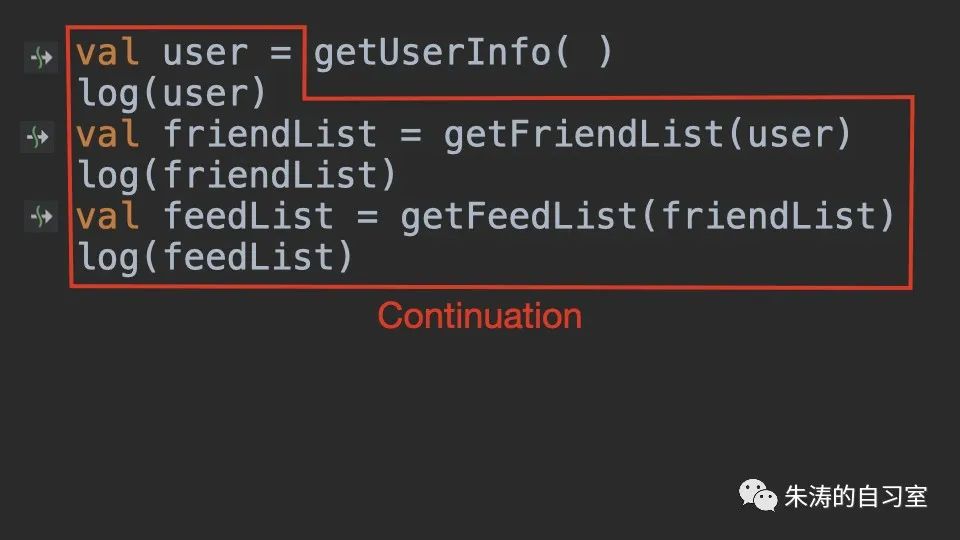
Continuation 就是接下来要运行的代码,剩余未执行的代码。
理解了 Continuation,以后,CPS就容易理解了,它其实就是:将程序接下来要执行的代码进行传递的一种模式。
而CPS 转换,就是将原本的同步挂起函数转换成CallBack 异步代码的过程。这个转换是编译器在背后做的,我们程序员对此无感知。

也许会有小伙伴嗤之以鼻:这么简单粗暴?三个挂起函数最终变成三个 Callback 吗?
当然不是。思想仍然是 CPS 的思想,但要比 Callback 高明很多。
接下来,我们一起看看挂起函数反编译后的代码是什么样吧。前面铺垫了这么多,全都是为了下一个部分准备的。
7. 字节码反编译
字节码反编译成 Java 这种事,我们干过很多次了。跟往常不同的是,这次我不会直接贴反编译后的代码,因为如果我直接贴出反编译后的 Java 代码,估计会吓退一大波人。协程反编译后的代码,逻辑实在是太绕了,可读性实在太差了。这样的代码,CPU 可能喜欢,但真不是人看的。
所以,为了方便大家理解,接下来我贴出的代码是我用 Kotlin 翻译后大致等价的代码,改善了可读性,抹掉了不必要的细节。「如果你能把这篇文章里所有内容都弄懂,你对协程的理解也已经超过大部分人了。」
进入正题,这是我们即将研究的对象,testCoroutine 反编译前的代码:
suspend fun testCoroutine() {
log("start")
val user = getUserInfo()
log(user)
val friendList = getFriendList(user)
log(friendList)
val feedList = getFeedList(friendList)
log(feedList)
}
反编译后,testCoroutine函数的签名变成了这样:
// 没了 suspend,多了 completion
fun testCoroutine(completion: Continuation<Any?>): Any? {}
由于其他几个函数也是挂起函数,所以它们的函数签名也会改变:
fun getUserInfo(completion: Continuation<Any?>): Any?{}
fun getFriendList(user: String, completion: Continuation<Any?>): Any?{}
fun getFeedList(friendList: String, completion: Continuation<Any?>): Any?{}
接下来我们分析 testCoroutine() 的函数体,因为它相当复杂,涉及到三个挂起函数的调用。
首先,在 testCoroutine 函数里,会多出一个 ContinuationImpl 的子类,它的是整个协程挂起函数的核心。代码里的注释非常详细,请仔细看。
fun testCoroutine(completion: Continuation<Any?>): Any? {
class TestContinuation(completion: Continuation<Any?>?) : ContinuationImpl(completion) {
// 表示协程状态机当前的状态
var label: Int = 0
// 协程返回结果
var result: Any? = null
// 用于保存之前协程的计算结果
var mUser: Any? = null
var mFriendList: Any? = null
// invokeSuspend 是协程的关键
// 它最终会调用 testCoroutine(this) 开启协程状态机
// 状态机相关代码就是后面的 when 语句
// 协程的本质,可以说就是 CPS + 状态机
override fun invokeSuspend(_result: Result<Any?>): Any? {
result = _result
label = label or Int.Companion.MIN_VALUE
return testCoroutine(this)
}
}
}
接下来则是要判断 testCoroutine 是不是初次运行,如果是初次运行,就要创建一个 TestContinuation 的实例对象。
// ↓
fun testCoroutine(completion: Continuation<Any?>): Any? {
...
val continuation = if (completion is TestContinuation) {
completion
} else {
// 作为参数
// ↓
TestContinuation(completion)
}
}
- invokeSuspend 最终会调用 testCoroutine,然后走到这个判断语句
- 如果是初次运行,会创建一个 TestContinuation 对象,completion 作为了参数
- 这相当于用一个 「新的」 Continuation 包装了 「旧的」 Continuation
- 如果不是初次运行,直接将 completion 赋值给 continuation
- 这说明 continuation 在整个运行期间,只会产生一个实例,这能极大的节省内存开销(对比 CallBack)
接下来是几个变量的定义,代码里会有详细的注释:
// 三个变量,对应原函数的三个变量
lateinit var user: String
lateinit var friendList: String
lateinit var feedList: String
// result 接收协程的运行结果
var result = continuation.result
// suspendReturn 接收挂起函数的返回值
var suspendReturn: Any? = null
// CoroutineSingletons 是个枚举类
// COROUTINE_SUSPENDED 代表当前函数被挂起了
val sFlag = CoroutineSingletons.COROUTINE_SUSPENDED
然后就到了我们的状态机的核心逻辑了,具体看注释吧:
when (continuation.label) {
0 -> {
// 检测异常
throwOnFailure(result)
log("start")
// 将 label 置为 1,准备进入下一次状态
continuation.label = 1
// 执行 getUserInfo
suspendReturn = getUserInfo(continuation)
// 判断是否挂起
if (suspendReturn == sFlag) {
return suspendReturn
} else {
result = suspendReturn
//go to next state
}
}
1 -> {
throwOnFailure(result)
// 获取 user 值
user = result as String
log(user)
// 将协程结果存到 continuation 里
continuation.mUser = user
// 准备进入下一个状态
continuation.label = 2
// 执行 getFriendList
suspendReturn = getFriendList(user, continuation)
// 判断是否挂起
if (suspendReturn == sFlag) {
return suspendReturn
} else {
result = suspendReturn
//go to next state
}
}
2 -> {
throwOnFailure(result)
user = continuation.mUser as String
// 获取 friendList 的值
friendList = result as String
log(friendList)
// 将协程结果存到 continuation 里
continuation.mUser = user
continuation.mFriendList = friendList
// 准备进入下一个状态
continuation.label = 3
// 执行 getFeedList
suspendReturn = getFeedList(friendList, continuation)
// 判断是否挂起
if (suspendReturn == sFlag) {
return suspendReturn
} else {
result = suspendReturn
//go to next state
}
}
3 -> {
throwOnFailure(result)
user = continuation.mUser as String
friendList = continuation.mFriendList as String
feedList = continuation.result as String
log(feedList)
loop = false
}
}
- when 表达式实现了协程状态机
continuation.label是状态流转的关键continuation.label改变一次,就代表协程切换了一次- 每次协程切换后,都会检查是否发生异常
- testCoroutine 里的原本的代码,被
拆分到状态机里各个状态中,分开执行 - getUserInfo(continuation),getFriendList(user, continuation),getFeedList(friendList, continuation) 三个函数调用传的同一个
continuation实例。 - 一个函数如果被挂起了,它的返回值会是:
CoroutineSingletons.COROUTINE_SUSPENDED - 切换协程之前,状态机会把之前的结果以成员变量的方式保存在
continuation中。
「警告:以上的代码是我用 Kotlin 写出的改良版反编译代码,协程反编译后真实的代码后面我也会放出来,请继续看。」
8. 协程状态机动画演示
上面一大串文字和代码看着是不是有点晕?请看看这个动画演示,看完动画演示了,回过头再看上面的文字,你会有更多收获。

是不是完了呢?并不,因为上面的动画仅演示了每个协程正常挂起的情况。如果协程并没有真正挂起呢?协程状态机会怎么运行?
协程未挂起的情况
要验证也很简单,我们将其中一个挂起函数改成伪挂起函数即可。
// “伪”挂起函数
// 虽然它有 suspend 修饰,但执行的时候并不会真正挂起,因为它函数体里没有其他挂起函数
// ↓
suspend fun noSuspendFriendList(user: String): String{
return "Tom, Jack"
}
suspend fun testNoSuspend() {
log("start")
val user = getUserInfo()
log(user)
// 变化在这里
// ↓
val friendList = noSuspendFriendList(user)
log(friendList)
val feedList = getFeedList(friendList)
log(feedList)
}
testNoSuspend()这样的一个函数体,它的反编译后的代码逻辑怎么样的?
答案其实很简单,「它的结构跟前面的testCoroutine()是一致的,只是函数名字变了而已,Kotlin 编译器 CPS 转换的逻辑只认 suspend 关键字」。就算是“伪”挂起函数,Kotlin 编译器也照样会进行 CPS 转换。
when (continuation.label) {
0 -> {
...
}
1 -> {
...
// 变化在这里
// ↓
suspendReturn = noSuspendFriendList(user, continuation)
// 判断是否挂起
if (suspendReturn == sFlag) {
return suspendReturn
} else {
result = suspendReturn
//go to next state
}
}
2 -> {
...
}
3 -> {
...
}
}
testNoSuspend()的协程状态机是怎么运行的?
其实很容易能想到,continuation.label = 0,2,3 的情况都是不变的,唯独在 label = 1 的时候,suspendReturn == sFlag这里会有区别。
具体区别我们通过动画来看吧:

通过动画我们很清楚的看到了,对于“伪”挂起函数,suspendReturn == sFlag是会走 else 分支的,在 else 分支里,协程状态机会直接进入下一个状态。
现在只剩最后一个问题了:
if (suspendReturn == sFlag) {
} else {
// 具体代码是如何实现的?
// ↓
//go to next state
}
答案其实也很简单:如果你去看协程状态机的字节码反编译后的 Java,会看到很多 label。协程状态机底层字节码是通过 label 来实现这个go to next state的。由于 Kotlin 没有类似 goto 的语法,下面我用伪代码来表示go to next state的逻辑。
// 伪代码
// Kotlin 没有这样的语法
// ↓ ↓
label: whenStart
when (continuation.label) {
0 -> {
...
}
1 -> {
...
suspendReturn = noSuspendFriendList(user, continuation)
if (suspendReturn == sFlag) {
return suspendReturn
} else {
result = suspendReturn
// 让程序跳转到 label 标记的地方
// 从而再执行一次 when 表达式
goto: whenStart
}
}
2 -> {
...
}
3 -> {
...
}
}
注意:以上是伪代码,它只是跟协程状态机字节码逻辑上等价,为了不毁掉你钻研协程的乐趣,我不打算在这里解释协程原始的字节码。我相信如果你理解了我的文章以后,再去看协程反编译的真实代码,一定会游刃有余。
下面的建议会有助于你看协程真实的字节码:协程状态机真实的原理是:通过 label 代码段嵌套,配合 switch 巧妙构造出一个状态机结构,这种逻辑比较复杂,相对难懂一些。(毕竟 Java 的 label 在实际开发中用的很少。)
真实的协程反编译代码大概长这样:
@Nullable
public static final Object testCoroutine(@NotNull Continuation $completion) {
Object $continuation;
label37: {
if ($completion instanceof <TestSuspendKt$testCoroutine$1>) {
$continuation = (<TestSuspendKt$testCoroutine$1>)$completion;
if ((((<TestSuspendKt$testCoroutine$1>)$continuation).label & Integer.MIN_VALUE) != 0) {
((<TestSuspendKt$testCoroutine$1>)$continuation).label -= Integer.MIN_VALUE;
break label37;
}
}
$continuation = new ContinuationImpl($completion) {
// $FF: synthetic field
Object result;
int label;
Object L$0;
Object L$1;
@Nullable
public final Object invokeSuspend(@NotNull Object $result) {
this.result = $result;
this.label |= Integer.MIN_VALUE;
return TestSuspendKt.testCoroutine(this);
}
};
}
Object var10000;
label31: {
String user;
String friendList;
Object var6;
label30: {
Object $result = ((<TestSuspendKt$testCoroutine$1>)$continuation).result;
var6 = IntrinsicsKt.getCOROUTINE_SUSPENDED();
switch(((<TestSuspendKt$testCoroutine$1>)$continuation).label) {
case 0:
ResultKt.throwOnFailure($result);
log("start");
((<TestSuspendKt$testCoroutine$1>)$continuation).label = 1;
var10000 = getUserInfo((Continuation)$continuation);
if (var10000 == var6) {
return var6;
}
break;
case 1:
ResultKt.throwOnFailure($result);
var10000 = $result;
break;
case 2:
user = (String)((<TestSuspendKt$testCoroutine$1>)$continuation).L$0;
ResultKt.throwOnFailure($result);
var10000 = $result;
break label30;
case 3:
friendList = (String)((<TestSuspendKt$testCoroutine$1>)$continuation).L$1;
user = (String)((<TestSuspendKt$testCoroutine$1>)$continuation).L$0;
ResultKt.throwOnFailure($result);
var10000 = $result;
break label31;
default:
throw new IllegalStateException("call to 'resume' before 'invoke' with coroutine");
}
user = (String)var10000;
log(user);
((<TestSuspendKt$testCoroutine$1>)$continuation).L$0 = user;
((<TestSuspendKt$testCoroutine$1>)$continuation).label = 2;
var10000 = getFriendList(user, (Continuation)$continuation);
if (var10000 == var6) {
return var6;
}
}
friendList = (String)var10000;
log(friendList);
((<TestSuspendKt$testCoroutine$1>)$continuation).L$0 = user;
((<TestSuspendKt$testCoroutine$1>)$continuation).L$1 = friendList;
((<TestSuspendKt$testCoroutine$1>)$continuation).label = 3;
var10000 = getFeedList(friendList, (Continuation)$continuation);
if (var10000 == var6) {
return var6;
}
}
String feedList = (String)var10000;
log(feedList);
return Unit.INSTANCE;
}
9. 结尾
回过头再看协程和线程的关系:
线程
- 线程是操作系统级别的概念
- 我们开发者通过编程语言(Thread.java)创建的线程,本质还是操作系统内核线程的映射
- JVM 中的线程与内核线程的存在映射关系,有“一对一”,“一对多”,“M对N”。JVM 在不同操作系统中的具体实现会有差别,“一对一”是主流
- 一般情况下,我们说的线程,都是内核线程,线程之间的切换,调度,都由操作系统负责
- 线程也会消耗操作系统资源,但比进程轻量得多
- 线程,是抢占式的,它们之间能共享内存资源,进程不行
- 线程共享资源导致了
多线程同步问题 - 有的编程语言会自己实现一套线程库,从而能在一个内核线程中实现多线程效果,早期 JVM 的“绿色线程” 就是这么做的,这种线程被称为“用户线程”
有的人会将线程比喻成:轻量级的进程。
协程
- Kotlin 协程,不是操作系统级别的概念,无需操作系统支持
- Kotlin 协程,有点像上面提到的“绿色线程”,一个线程上可以运行成千上万个协程
- Kotlin 协程,是用户态的(userlevel),内核对协程 「无感知」
- Kotlin 协程,是协作式的,由开发者管理,不需要操作系统进行调度和切换,也没有抢占式的消耗,因此它更加 「高效」
- Kotlin 协程,它底层基于状态机实现,多协程之间共用一个实例,资源开销极小,因此它更加 「轻量」
- Kotlin 协程,本质还是运行于线程之上,它通过协程调度器,可以运行到不同的线程上
挂起函数是 Kotlin 协程最关键的内容,一定要理解透彻。
文中所有代码都已在 Demo 中提供,看完文章以后,你一定会有不少疑惑,一定要去实际调试运行:https://github.com/chaxiu/KotlinJetpackInAction[4]
